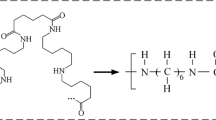Abstract
WE show here that the friction on metal of poly(ethylene-terephthalate) (PET), nylon-6,6 and polyacrylonitrile (PAN) yarns increases when the yarns are dyed, each with a different dye. This phenomenon is well known in the textile industry, but it has only been investigated quantitatively in one case, the friction of dyed wool on metal1. Our results show that it is a general phenomenon, and that it is possible to change the mechanical properties of a polymer by the addition of small molecules which have an affinity for the polymer chains.
This is a preview of subscription content, access via your institution
Access options
Subscribe to this journal
Receive 51 print issues and online access
$199.00 per year
only $3.90 per issue
Buy this article
- Purchase on Springer Link
- Instant access to full article PDF
Prices may be subject to local taxes which are calculated during checkout
Similar content being viewed by others
References
Slinger, R. I. & Veldsman, D. P. 3rd Int. Wool Textile Res. Conf., Paris 3, 277–286 (1965).
Bowden, F. P. & Tabor, D. Friction and Lubrication of Solids Vol. 2 (Clarendon, Oxford, 1964).
Howell, H. G., Mieszkis, K. W. & Tabor, D. Friction in Textiles (Butterworths, London, 1959).
Schick, M. J. in Surface Characteristics of Fibers and Textiles part 2 (ed. Schick, M. J.) 1 (Marcel Dekker, New York, 1975).
Grosberg, P. & Plate, D. E. A. J. Textile Inst. 62, 116 (1971).
Author information
Authors and Affiliations
Rights and permissions
About this article
Cite this article
HEPWORTH, K., HEWA-KAPUGE, A., MUNDEN, D. et al. Dyeing increases the friction of synthetic polymer yarns. Nature 276, 250–252 (1978). https://doi.org/10.1038/276250b0
Received:
Accepted:
Issue Date:
DOI: https://doi.org/10.1038/276250b0
Comments
By submitting a comment you agree to abide by our Terms and Community Guidelines. If you find something abusive or that does not comply with our terms or guidelines please flag it as inappropriate.



